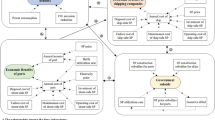Abstract
A platform for the study of the whole transmission problem (arrival of ships, regasification, transportation and distribution) faced by gas utilities companies is proposed. The main objective of this research is to develop a platform that includes the analysis of the new capacity auctions (and not the traditional commodity auctions) that will govern the supply chain in the near future. A simulation-optimization approach has been used to favour the more realistic abstraction of the system. The discrete-event model includes a genetic algorithm to reach the solution in a satisfactory short time, a requisite in auction markets. Design and optimization studies for the utilities are addressed using the platform, which has been validated with real data for one of the main zones in the Spanish market.





Similar content being viewed by others
References
April J, Glover F, Kelly JP and Laguna M (2003). Practical introduction to simulation optimization. In: Chick S, Sánchez PJ, Ferrin D and Morrice DJ (eds). Proceedings of the 2003 Winter Simulation Conference. IEEE; New Jersey, pp 71–78.
Avery W, Brown GG, Rosenkranz JA and Wood K (1992). Optimization of purchase, storage and transmission contracts for natural gas utilities. Operations Research 40: 446–462.
Caton HG (1984). Gas supply and storage planning: A simulation approach. Journal of Operational Research Society 35: 593–596.
Clark M (1985). The development of a simulation model for the operation of the national gas transmission system. Journal of Operational Research Society 36: 275–283.
Duffuaa SO, Al-Zayer JA, Al-Marhoun MA and Al-Saleh MA (1992). A linear programming model to evaluate gas availability for vital industries in Saudi Arabia. Journal of Operational Research Society 43: 1035–1045.
Energiadiario.com (2009). http://www.energiadiario.com/publicacion/spip.php?article6415.
Fazlollahi B and Vahidov R (2001). Extending the effectiveness of simulation-based DSS through genetic algorithms. Information & Management 39: 53–65.
Guldmann JM (1983). Supply, storage and service reliability decisions by gas distribution utilities: A chance-constrained approach. Management Science 29: 884–906.
Kleijnen JPC and Smits MT (2003). Performance metrics in supply chain management. Journal of Operational Research Society 54: 507–514.
Law A and Kelton WD (1991). Simulation Model and Analysis. McGraw-Hill: New York.
Lise W, Hobbs BF and van Oostvoorn F (2008). Natural gas corridors between the EU and its main suppliers: Simulation results with the dynamic GASTALE model. Energy Policy 36: 1890–1906.
Nearchou AC (2004). The effect of various operators on the genetic search for large scheduling problems. International Journal of Production Economics 88: 191–203.
Olaya Y and Dyner I (2005). Modelling for policy assessment in the natural gas industry. Journal of Operational Research Society 56: 1122–1131.
Otamendi J (2008). Visualization and scheduling of jetty operations in harbours. Proceedings of the Sixth International Conference on Simulation in Industry and Services. Public University of Navarre, pp 31–52.
Portante EC, Craig BA and Folga SM (2007). NGfast: A simulation model for rapid assessment of impacts of natural gas pipeline breaks and flow reductions at US state borders and import points. In: Henderson SG, Biller B, Hsieh MH, Shortle J, Tew JD and Barton RR (eds). Simulation Conference, 2007 Winter, 9–12 December, pp 1118–1226.
Singer M, Donoso P and Jara S (2002). Fleet configuration subject to stochastic demand: An application in the distribution of liquefied petroleum gas. Journal of Operational Research Society 53: 961–971.
Sivrikaya F and Ulusoy G (2004). Multiprocessor task scheduling in multistage hybrid flow-shops: A genetic algorithm approach. Journal of Operational Research Society 55: 504–512.
Author information
Authors and Affiliations
Rights and permissions
About this article
Cite this article
Otamendi, F., Doncel, L. Towards an auction-driven gas supply: a simulation-based optimization framework for utilities. J Oper Res Soc 63, 1189–1198 (2012). https://doi.org/10.1057/jors.2011.128
Received:
Accepted:
Published:
Issue Date:
DOI: https://doi.org/10.1057/jors.2011.128




